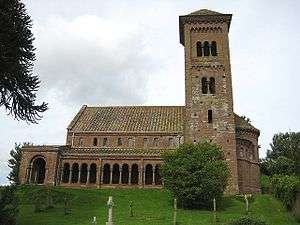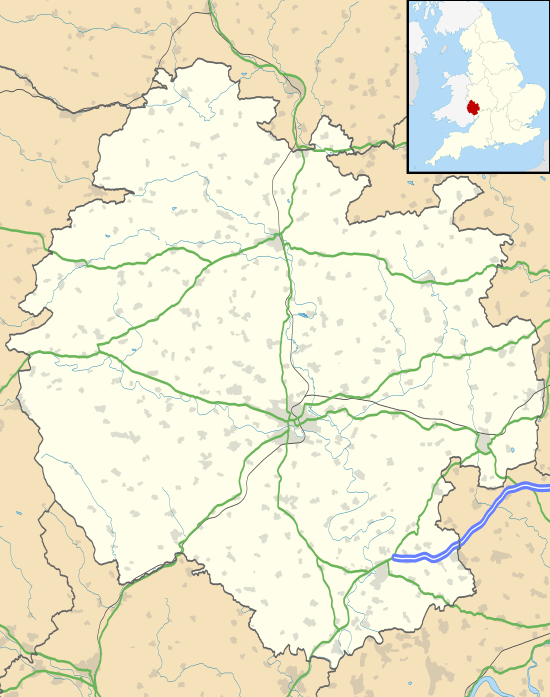St Catherine's Church, Hoarwithy
| St Catherine's Church, Hoarwithy | |
|---|---|
| Church of St Catherine, Hoarwithy | |
 Church of St Catherine, Hoarwithy | |
 St Catherine's Church, Hoarwithy Location in Herefordshire | |
| Coordinates: 51°57′41″N 2°39′45″W / 51.9613°N 2.6625°W | |
| Location | Hoarwithy, Herefordshire |
| Country | England |
| Denomination | Anglican |
| Website | |
| History | |
| Status | Parish church |
| Architecture | |
| Functional status | Active |
| Heritage designation | Grade I |
| Designated | 26 March 1987 |
| Architect(s) | John Pollard Seddon |
| Architectural type | Church |
| Groundbreaking | c.1870 |
| Completed | 1901 |
| Administration | |
| Parish | Hentland |
| Diocese | Diocese of Hereford |
| Clergy | |
| Vicar(s) | Revd Elizabeth Davies |
| Assistant priest(s) | Revd Frances Phillips |
The Church of St Catherine is a Church of England parish church at Hoarwithy in the English county of Herefordshire. Brooks and Pevsner describe it as "the most impressive Victorian church in the county.[1] Designed in an Italian Romanesque[1] style by the architect John Pollard Seddon[1] for the Revd William Poole, vicar of Hentland with Hoarwithy,[1] it is a Grade I listed building.[2]
History
The original chapel on the site was a "brick building"[1] of the 1840s which Poole considered; "An ugly brick building with no pretensions to any style of architecture."[3] Coming into his inheritance in 1870, Poole commissioned Seddon to undertake a total rebuilding.[3] The building history is "unclear";[1] designs were exhibited at the Royal Academy in 1874, and the main building period appears to have been 1878-79,[1] although English Heritage records much work as post-dating 1885.[4] Brooks and Pevsner consider that this may relate "largely to the internal decoration."[1] Work has continued into the 21st century with the addition of the "Dubricius" polyptych[5] by the artist Edward Kelly,[6] and the restoration of the organ.[7]
Description
The church has an "imposing campanile,"[1] of four storeys, with an open arcaded ground floor.[1] The church is of sandstone, which encases the brick structure of 1840. A North porch is linked to the arcades of the campanile by a loggia.[8] Historic England describes the design of the church as "eclectic Rundbogenstil"[8] with "Byzantine, French, Venetian, Lombardic, Tuscan and Sicilian Romanesque influences."[9] Simon Jenkins considers the church; "a complete work of revivalist art, rare for its date, an astonishing creation."[10]
Notes
- 1 2 3 4 5 6 7 8 9 10 Brooks & Pevsner 2012, p. 363.
- ↑ "CHURCH OF ST CATHERINE - 1214570". Historic England. 1987-03-26. Retrieved 2016-09-23.
- 1 2 "The Parish Churches of Hentland and Hoarwithy". Hentlandandhoarwithy.co.uk. 1904-02-23. Retrieved 2016-09-23.
- ↑ "CHURCH OF ST CATHERINE - 1214570". Historic England. 1987-03-26. Retrieved 2016-09-23.
- ↑ "Paintings". Edward Kelly. Retrieved 2016-09-23.
- ↑ Brooks & Pevsner 2012, p. 364.
- ↑ "St Weonards group website - News". Stw.org.uk. Retrieved 2016-09-23.
- 1 2 "CHURCH OF ST CATHERINE - 1214570". Historic England. 1987-03-26. Retrieved 2016-09-25.
- ↑ Good Stuff (1987-03-26). "Church of St Catherine - Hentland - Herefordshire - England". British Listed Buildings. Retrieved 2016-09-25.
- ↑ Jenkins 1999, pp. 269-70.
Sources
- Brooks, Alan; Pevsner, Nikolaus (2012). Herefordshire. The Buildings of England. Yale University Press. ISBN 978-0-300-12575-7.
- Jenkins, Simon (1999). England's Thousand Best Churches. Penguin. ISBN 0-713-99281-6.
| Wikimedia Commons has media related to St Catherine's Church, Hoarwithy. |